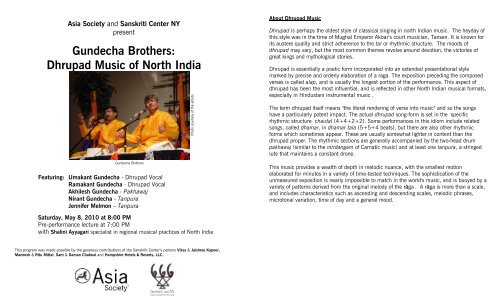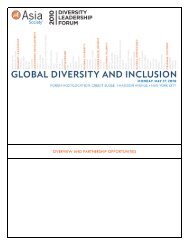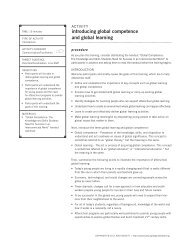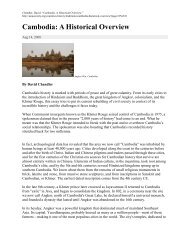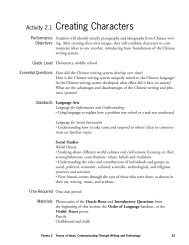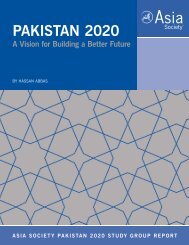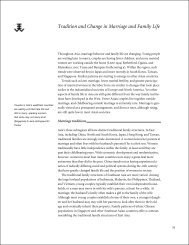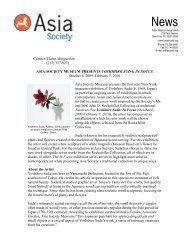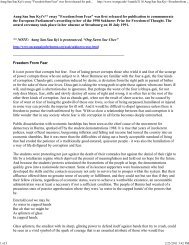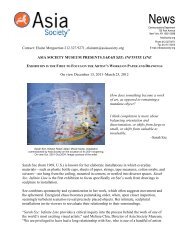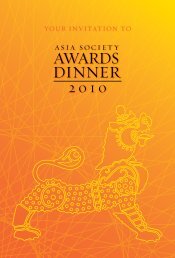Prg notes Gundecha Brothers 2010 for WEB - Asia Society
Prg notes Gundecha Brothers 2010 for WEB - Asia Society
Prg notes Gundecha Brothers 2010 for WEB - Asia Society
You also want an ePaper? Increase the reach of your titles
YUMPU automatically turns print PDFs into web optimized ePapers that Google loves.
<strong>Asia</strong> <strong>Society</strong> and Sanskriti Center NY<br />
present<br />
<strong>Gundecha</strong> <strong>Brothers</strong>:<br />
Dhrupad Music of North India<br />
<strong>Gundecha</strong> <strong>Brothers</strong><br />
Featuring: Umakant <strong>Gundecha</strong> - Dhrupad Vocal<br />
Ramakant <strong>Gundecha</strong> - Dhrupad Vocal<br />
Akhilesh <strong>Gundecha</strong> - Pakhawaj<br />
Nirant <strong>Gundecha</strong> - Tanpura<br />
Jennifer Melmon – Tanpura<br />
Photo courtesy of the artists<br />
About Dhrupad Music<br />
Dhrupad is perhaps the oldest style of classical singing in north Indian music. The heyday of<br />
this style was in the time of Mughal Emperor Akbar’s court musician, Tansen. It is known <strong>for</strong><br />
its austere quality and strict adherence to the tal or rhythmic structure. The moods of<br />
dhrupad may vary, but the most common themes revolve around devotion, the victories of<br />
great kings and mythological stories.<br />
Dhrupad is essentially a poetic <strong>for</strong>m incorporated into an extended presentational style<br />
marked by precise and orderly elaboration of a raga. The exposition preceding the composed<br />
verses is called alap, and is usually the longest portion of the per<strong>for</strong>mance. This aspect of<br />
dhrupad has been the most influential, and is reflected in other North Indian musical <strong>for</strong>mats,<br />
especially in Hindustani instrumental music .<br />
The term dhrupad itself means "the literal rendering of verse into music" and so the songs<br />
have a particularly potent impact. The actual dhrupad song-<strong>for</strong>m is set in the specific<br />
rhythmic structure chautal (4+4+2+2). Some per<strong>for</strong>mances in this idiom include related<br />
songs, called dhamar, in dhamar tala (5+5+4 beats), but there are also other rhythmic<br />
<strong>for</strong>ms which sometimes appear. These are usually somewhat lighter in content than the<br />
dhrupad proper. The rhythmic sections are generally accompanied by the two-head drum<br />
pakhawaj (similar to the mridangam of Carnatic music) and at least one tanpura, a stringed<br />
lute that maintains a constant drone.<br />
This music provides a wealth of depth in melodic nuance, with the smallest motion<br />
elaborated <strong>for</strong> minutes in a variety of time-tested techniques. The sophistication of the<br />
unmeasured exposition is nearly impossible to match in the world's music, and is buoyed by a<br />
variety of patterns derived from the original melody of the rāga . A rāga is more than a scale,<br />
and includes characteristics such as ascending and descending scales, melodic phrases,<br />
microtonal variation, time of day and a general mood.<br />
Saturday, May 8, <strong>2010</strong> at 8:00 PM<br />
Pre-per<strong>for</strong>mance lecture at 7:00 PM<br />
with Shalini Ayyagari specialist in regional musical practices of North India<br />
This program was made possible by the generous contributions of the Sanskriti Center’s patrons Vikas & Jaishree Kapoor,<br />
Maneesh & Ritu Mittal, Sant & Daman Chatwal and Hampshire Hotels & Resorts, LLC.
Pre-Per<strong>for</strong>mance Lecture<br />
Lecture by Shalini Ayyagari<br />
About the Speaker<br />
Shalini Ayyagari, a Mellon Postdoctoral Fellow in the Humanities at Dartmouth College, is<br />
a specialist in the regional musical practices of North India. She received her doctorate in<br />
Ethnomusicology from the University of Cali<strong>for</strong>nia, Berkeley. Her research examines intersections<br />
of development initiatives and music-making as members of the Manganiyar hereditary<br />
musician community are founding their own non-governmental organizations to<br />
grapple with community and caste issues in northwestern India. She is also currently working<br />
on a project which looks at the India-Pakistan border region as a site <strong>for</strong> borderlands<br />
music-making. Ayyagari is an avid Hindustani tabla and Balinese Gamelan player.<br />
Program<br />
1- Raga Jaijaivanti (late night) Mood shringar (love) taal: Choutal,<br />
<strong>notes</strong>: SRGMPNS, SN (komal) DPMGRS,<br />
western: CDEFGBC (ascending) CBbAGFEDC (descending)<br />
Bols are dha dha din ta kit dha din ta tit kat gadi gana<br />
5 divisions of 2 beats<br />
1, 5. 9 and 11 clapping<br />
3 and 7 empty<br />
Author: Unknown/Language: Brij<br />
Lyrics:<br />
Ek samaya radhika mukhana banaye ang chali sang shyamju ke<br />
kar singar roop bano tihare hi mukh ko, dekh ke swaroop ko chandra hun lajaya rahe<br />
Translation:<br />
Seeing the beauty and radiance of Radha Rani as she accompanied Shyam,<br />
the moon blushed as he saw her dressed <strong>for</strong> her Krishna and hid behind the clouds.<br />
2- Raga Hansadhvani (evening) - Mood bhakti (devotional) Taal (rhythm)- Choutal,<br />
<strong>notes</strong>: SRGPNS<br />
western: CDEGBC (same descending) Usool-e Faqta<br />
10 beats - Dha Gid Nag Dhig Gid Nag Gad Dhig Gid Nag<br />
five sections of 2 beats/tali (clap) on 1, 5 and 7 and khali (wave) on 3 and 9<br />
Author: Guru Nanak (15 April 1469 – 22 September 1539) is the first of the ten Sikh Gurus.<br />
Sikhs believe that all subsequent Gurus possessed Guru Nanak's divinity and religious<br />
authority. Guru Nanak's teachings can be found in the Sikh scripture Guru Granth Sahib, a<br />
vast collection of revelatory verses recorded in Gurmukhi.<br />
Language: Hindi<br />
Lyrics:<br />
Sadho mana ka maan tyago<br />
kaam krodh sangat durjan ki<br />
tate ahanis bhago<br />
Sukh dukh dono sam kari jano<br />
aur maan apamana<br />
harsha shok te rahe atita<br />
tin jag tatva pahchana<br />
Stuti ninda dou tyago<br />
khoje pada nirvana<br />
jana nanak yeh khel kathin hai<br />
khou gurumukh jana<br />
Translation:<br />
Guru Nanak Deva states:<br />
Let the mind be clear and still like a lake<br />
Let the mind be devoid of pride,<br />
Let it be free of desire and anger,<br />
Treat Happiness and Sorrow with equal equanimity,<br />
Let not be affected by pride or insults,<br />
Joy and sorrow, praise and criticism should not matter<br />
Recognize the elements of the three worlds,<br />
Attain a state of Nirvana.<br />
3 - Raga Charukeshi (“Late Morning”). Mood Shanti (peace)<br />
Taal: Sooltal, Charukeshi is the 26th mela of the Karnatic organizational system of ragas.<br />
<strong>notes</strong>: SRGMPD (komal) N (komal) S<br />
western: CDEFGAbBbC (same descending)<br />
Author: Kabir. Kabir was born in the year 1398AD, 71 years be<strong>for</strong>e Guru Nanak. He was<br />
never <strong>for</strong>mally educated and was almost completely illiterate. Kabir is one of India's most<br />
quoted poets and mystics. He is spiritually significant to Hindus, Sikhs, and Muslims alike.<br />
Kabir openly criticized all sects and gave a new direction to Indian philosophy.<br />
Language: Avadhi<br />
Lyrics:<br />
Jhini Jhini bini chadariya<br />
Kahe ke tana kahe ke bharani<br />
kauna tara se bini chadariya<br />
ingala pingala tana bharani<br />
sushumana tara se bini chadariya
pancha tattva guni bini chadariya<br />
jo chadara sura nara muni odhi<br />
Odhi ke maili kinhi chadariya<br />
Dasa kabira jatana se odhi<br />
jyun ki tyun dhara dini chadariya<br />
Poet Kabir Das says: “When I was born, the world smiled and cried. However, I will do<br />
such deeds that when I leave, I will be the one smiling and the world will be the one crying.”<br />
This life is like a very thin transparent shawl which should be drenched in the holy<br />
name of Lord Rama, the Reservoir of Pleasure. 2) The eight lotuses is the spinning wheel<br />
using the five earthly elements to make the chadar (the body). In nine of ten days, the chadar<br />
is completed; however, the fools will destroy it. 3) When the chadar is completed, it is<br />
sent to the dyer (the spiritual master) to color it. The dyer (the spiritual master) colored it<br />
as such that it is all red (the color of self-realization). 4) Do not have doubts or fears while<br />
wearing this chadar. It is only given to you <strong>for</strong> two days and it is temporary too. The foolish<br />
people do not understand the temporariness of this chadar, and they day by day destroy it.<br />
The servant, Kabir Dasa, is attempting to wear this chadar as given to him originally by his<br />
guru. Kabir says: “I have covered myself with this cloth with great care and eventually I<br />
will leave it like it was.”<br />
4- Raga Shivaranjani Shivaranjani-taal: Sooltal,<br />
<strong>notes</strong>: SRG (komal) PDS<br />
western: CDEbGAC (same descending)<br />
This is a very melodious raga and is sung during late evenings. As the name suggests, this<br />
raga is used to compose tunes to please the fearsome Lord of destruction, Shiva. This raga<br />
is known to evoke the moods of romance and sorrow. Sometimes liberty is taken with raga<br />
Shivranjani and Shudha Gandhar (Ga) may be used by some musicians. Raga Shivranjani<br />
is originally from South Indian Classical music later adapted in North India. This song is in<br />
praise of Devi.<br />
Author: Guru Mata Amma Sridhar Sri Gudda<br />
Language: Sanskrit<br />
Lyrics:<br />
Sandhya sanjivani sur samadhi rupini<br />
gayatri trivarg dhatri savitri trilok yatri<br />
mahamantra mahayantra mahatantrini<br />
rahoyaga krimaradya rahstarpini<br />
om lum vam ram rhim yam<br />
About the Artists<br />
Umakant and Ramakant <strong>Gundecha</strong> are India's leading exponents of the Dhrupad style of<br />
music. They are among the most active young per<strong>for</strong>mers of Dhrupad in Indian and<br />
international circuits. Born in Ujjain in Central India, both were initiated into music by<br />
their parents.<br />
The <strong>Gundecha</strong> <strong>Brothers</strong> received conventional university education and learned the<br />
Dhrupad vocal art under the renowned Dhrupad vocalist Ustad Zia Fariduddin Dagar, and<br />
also with Ustad Zia Mohiuddin Dagar (the distinguished per<strong>for</strong>mer of Rudra Veena) in<br />
Dhrupad Kendra Bhopal.<br />
The <strong>Gundecha</strong> <strong>Brothers</strong> have sung poetry by the great poets of Hindi, Tulsidas, Kabir,<br />
Padmakar, and Nirala in Dhrupad style. They have recorded approximately 25 cassettes<br />
and CDs with H.M.V, Music Today, Rhythm House, Senseworld Music, Sundaram<br />
Records, IPPNW Concerts Berlin, Navras and Audio Rec London. They have also sung <strong>for</strong><br />
many television channels in India and have been broadcast on British, American, German,<br />
French, Japanese, and Australian radio as well. In addition to being an integral part of all<br />
of India's prestigious music festivals, the <strong>Brothers</strong> have also per<strong>for</strong>med at many important<br />
international music festivals and institutions in over25 countries, including throughout<br />
Europe, the U.S., Australia, Japan, Egypt, Singapore, Bangladesh, U.A.E, and Hongkong.<br />
They received an M.P. Government Scholarship from 1981 to 1985, a National<br />
Fellowship from 1987 to 89, and the Ustad Allauddin Khan Fellowship in 1993. They<br />
have also received numerous awards, such as the Sanskriti Award in 1994, the Kumar<br />
Gandharva Award in 1998 given by the Government of Madhya Pradesh, and the Dagar<br />
Gharana Award from the Mewar Foundation in 2001.<br />
Akhilesh <strong>Gundecha</strong> learned Pakhawaj playing from Pandit Shrikant Mishra and Raja<br />
Chhatrapati Singh JuDeo. He has a postgraduate degree in music and also graduated in<br />
Law. He received a scholarship from Ustad Allauddin Khan <strong>for</strong> Sangeet Academy in<br />
Bhopal from the Indian government. He has accompanied many of the Dhrupad Maestros<br />
such as Ustad Z.F. Dagar, Ustad Fahimuddin Dagar, Pt. Siyaram Tiwari, Shrimati Asgari<br />
Bai, Dr. Ritwik Sanyal and Bahauddin Dagar. He has also played solo recitals at the<br />
Tansen Festival in Gwalior, the Haridas Sangeet Samaroh in Mumbai, the Dhrupad<br />
Samaroh in Bhopal, and many other festivals. He has toured throughout Germany,<br />
Switzerland, Hong Kong, the USA and Canada, and is regularly featured on radio and<br />
television.<br />
Translation:<br />
Composition in praise of the all pervading goddess Devi, the shining one.
Tanpura<br />
Pakhavaj<br />
About the Instruments<br />
Tanpura is a drone instrument. It resembles a sitar except it has<br />
no frets. It has four strings tuned to important pitches of the<br />
raga. The word "tanpura" (tanpoora) is common in the north, but<br />
in south India it is called "tambura", "thamboora". The tanpura is<br />
known <strong>for</strong> its very rich sound. There are three main styles; the<br />
Miraj style, the Tanjore style and the small instrumental version<br />
sometimes called tamburi.<br />
The Miraj style is the typical north Indian tanpura (tambura). This<br />
is the favorite of Hindustani musicians. It typically is between 3 to<br />
5 feet in length. It is characterized by a pear shaped, well<br />
rounded tabali (resonator face) and non-tapering neck. It usually<br />
has a resonator made of a gourd, but rarely one may find<br />
resonators made of wood. It does not partake in the melodic part<br />
of the music but it supports and sustains the melody by providing<br />
a very colorful and dynamic harmonic resonance field based on<br />
precise tones, and including the neutral pitch of the raga.<br />
The Pakhavaj, also called Mardal, Pakhawaj, Pakuaj, is an Indian<br />
barrel-shaped, two-headed drum, the North Indian equivalent to<br />
the Southern mridangam. It is the standard percussion instrument<br />
in the dhrupad style and is widely used as an accompaniment <strong>for</strong><br />
various <strong>for</strong>ms of music and dance per<strong>for</strong>mances. The pakhavaj has<br />
a low, mellow tone, very rich in harmonics. Set horizontally on a<br />
cushion in front of the drummer's crossed leg, the larger bass-skin<br />
is played with the left hand and the treble skin by the right hand.<br />
The pakhawaj rhythms are taught by a series of mnemonic<br />
syllables known as bols.<br />
<strong>Asia</strong> <strong>Society</strong> Staff<br />
Rachel Cooper, Director, Cultural Programs and Per<strong>for</strong>ming Arts<br />
Sébastien Haizet, Program Officer, Cultural Programs<br />
Eric DeArmon, Audio Visual Manager<br />
David Mason, Audio Engineer<br />
John Valencia, Audio Engineer<br />
Eric Chase, Lighting technician<br />
Matt Klammer, Videographer<br />
Elaine Merguerian, Associate Director, Communications<br />
Jeff Tompkins, Producer, <strong>Asia</strong> <strong>Society</strong> Online<br />
Paul Bolinger, Box Office Manager<br />
Per<strong>for</strong>ming Arts programming at the <strong>Asia</strong> <strong>Society</strong> is made possible in part by support from the Doris Duke<br />
Charitable Foundation, Helen and Will Little Endowment <strong>for</strong> Per<strong>for</strong>ming Arts, the New York State Council on<br />
the Arts and The Fan Fox and Leslie R. Samuels Foundation, Inc.<br />
About the Sanskriti Center NY<br />
Sanskriti’s goal is to promote and preserve the legacy of Indian culture by imparting the gift<br />
of that rich tradition to the children of the greater New York area. Sanskriti works to instill<br />
its students with an abiding appreciation of India’s heritage, to trans<strong>for</strong>m them into cultural<br />
ambassadors. Through arts in education and promoting all artists Sanskriti is committed to<br />
building bridges not only between America and India, but between the past and the present<br />
cultural history of India. Our Motto is “SA VIDYA YA VIMUCHYATE” Knowledge is that which<br />
liberates. For more in<strong>for</strong>mation, see http://www.sanskriticenter.org<br />
The Sanskriti Center NY Staff<br />
725 Park Avenue<br />
New York. NY 10021<br />
www.asiasociety.org<br />
Founder, President and Director of Per<strong>for</strong>ming Arts: Swati Bhise<br />
Executive Director: Abha (Bunty) Sawhney<br />
Treasurer and Secretary: Fran Mikaloff


